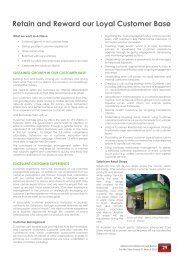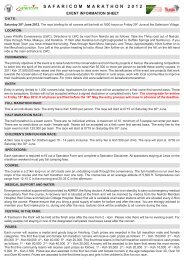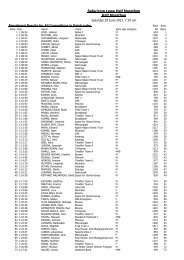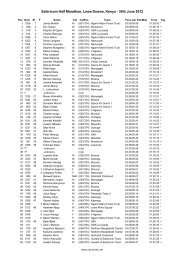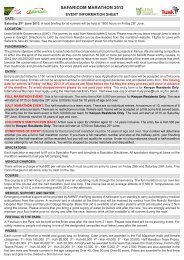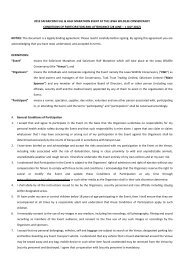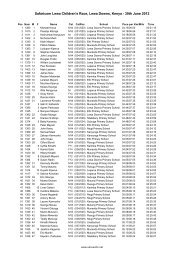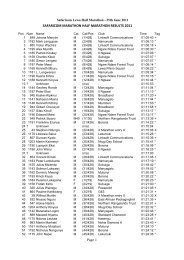Sustainability Performance: At a glance (31 March 2012) - Safaricom
Sustainability Performance: At a glance (31 March 2012) - Safaricom
Sustainability Performance: At a glance (31 March 2012) - Safaricom
Create successful ePaper yourself
Turn your PDF publications into a flip-book with our unique Google optimized e-Paper software.
Our sustainability strategy<br />
4.1. Our strategic vision<br />
<strong>Sustainability</strong> is fundamental to our strategic<br />
thinking. As this report reflects, we understand<br />
that we have a significant role to play as a<br />
responsible corporate citizen, and take the<br />
cumulative effect of our activities on long-term<br />
sustainability very seriously.<br />
As a growing organisation, we appreciate the<br />
importance of managing our carbon footprint.<br />
The first step is to measure our emissions and<br />
these are reported on in this document.<br />
We maintain three to five year strategic<br />
planning cycles and review the social,<br />
environmental and economic contexts of our<br />
operations during each cycle.<br />
Transforming lives<br />
4.2. How we manage risk<br />
Risk Management at <strong>Safaricom</strong> is promoted and<br />
promulgated by the Risk Management Division.<br />
The division works with management to address<br />
key risks in the telecommunications environment<br />
— including revenue assurance and fraud,<br />
information systems auditing, security, and<br />
business improvements and controls — using a<br />
credible Enterprise Risk Management<br />
(ERM) process.<br />
Most environmentally compliant<br />
In December 2010, we were distinguished<br />
as the most environmentally compliant<br />
firm in telecommunications by the National<br />
Environment Management Authority.<br />
Growth towards Total<br />
Communications<br />
Sustain Voice<br />
Revenue<br />
<strong>Performance</strong><br />
Maintain market<br />
leadership in subscriber<br />
& revenue market<br />
share<br />
Grow all revenue<br />
streams through<br />
value addition<br />
Capitalise on the<br />
data opportunity<br />
Increase penetration<br />
under financial<br />
services<br />
Drive organisational<br />
performance &<br />
generate returns<br />
Continued cost<br />
reduction programs<br />
Rare Unlikely Possible Likely Certain<br />
46 <strong>Safaricom</strong> <strong>Sustainability</strong> Report <strong>2012</strong> <strong>Safaricom</strong> <strong>Sustainability</strong> Report <strong>2012</strong> 47<br />
5<br />
4<br />
3<br />
2<br />
1<br />
IMPACT<br />
Our ERM process is based on the COSO framework. It uses a defined risk universe and definitive<br />
scales of 1 to 5 for ‘likelihood’ and ‘impact’. Established risk registers are reviewed by division<br />
managers, with risks re-assessed quarterly. The divisional assessments are compiled by the enterprise<br />
risk team and the critical and high risks are presented to, reviewed, discussed and moderated as<br />
necessary by the Executive Committee (Ex-Co).<br />
4.3. Our sustainability risks<br />
In determining our sustainability risks, <strong>Safaricom</strong> engaged KPMG to undertake a sustainability risk<br />
materiality assessment for the business. KPMG interviewed eight Ex-Co members to identify the crossfunctional<br />
risks to the business.<br />
The identified risks were then grouped together into eight risk categories, with associated sub-risks.<br />
Once categorised, Ex-Co members were asked to rank each risk category using <strong>Safaricom</strong>’s existing<br />
ERM criteria at a materiality assessment workshop.<br />
The outcome of the materiality assessment is presented in the sustainability risk heat map below.<br />
LIKELIHOOD<br />
1 2 3 4 5<br />
R4<br />
R6<br />
R8<br />
R7<br />
R3<br />
R1<br />
R2<br />
R5<br />
Our sustainability strategy<br />
The heat map plots each of the eight identified risks (R1 to R8) in terms of the possibility<br />
or ‘likelihood’ of the risk happening and the potential damage or ‘impact’ it will have on the<br />
business should it occur.<br />
R1 Dynamic Regulatory Environment<br />
R2 Energy Security<br />
R3 Network Stability<br />
R4 Innovation<br />
R5 Supplier Ethics & <strong>Performance</strong><br />
R6 Ethics and Values<br />
R7 Employee Environment<br />
R8 Environmental <strong>Performance</strong>



